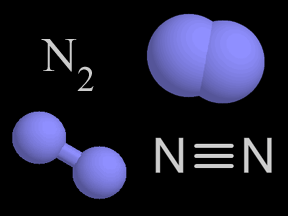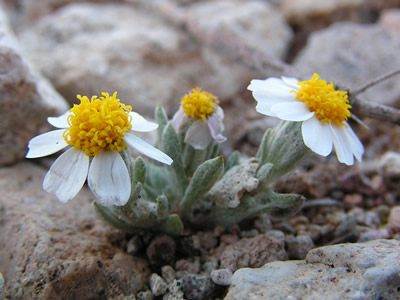Eriophyllum lanosum, one of the desert winter annuals that Larry Venable, an ecologist at the University of Arizona in Tucson, and his collaborators monitored for 26 years. The photo was taken in March 2008.
Click on image for full size
Image Courtesy of Jonathon Horst
Even in the Desert, Plants Feel the Heat of Global Warming
Scientists who study plants in the Sonoran Desert are worried about global warming.
Desert winters have become warmer and drier over the years, and climate changes have pushed the arrival of winter rains later in the winter season. This forces some winter annual to come out when temperatures are colder.
Larry Venable, an ecologist at the University of Arizona (UA) in Tucson, has been studying something called "bet-hedging" in plants. Bet-hedging is an adaptation seeds make to help them survive when conditions in the environment aren't good. The seeds delay their germination until the conditions are better. This delay can be caused by lack of rainfall, lack of nutrients, temperatures that are too hot or too cold, or any other condition that would affect the survival of a seed.
Researchers measure carbon and nitrogen in the plants' leaves to learn how well the different species grow at winter's lower temperatures. The amount of carbon in a plant's leaves tells scientists how well a plant has adapted to water storage in cold weather. Higher amounts of nitrogen can mean that the plant is better at gathering light in cold weather and is better able to photosynthesize.
If plants are better at photosynthesis, they are more able to use energy from sunlight and convert it into food, which improves the plant's chances for survival. They also found that plants that are better at storing water do better in colder environments.
You might also be interested in:

Have you ever taken your temperature to see if you are getting sick? Scientists have been taking the Earth's temperature and have found that it is getting warmer. During the past 100 years, the Earth's
...more
Raindrops form when tiny water droplets collide together in clouds to form bigger ones. When they get too heavy, rain falls out of the clouds. Rain is more than 5mm in diameter. The types of clouds that
...more
There is more nitrogen gas in the air than any other kind of gas. About four out of five of the molecules in Earth's atmosphere is nitrogen gas! A molecule of nitrogen gas is made up of two nitrogen atoms.
...more
There are many different kinds of plants. Some have big leaves. Some have small leaves. Some even have flowers. All plants make their own food. When sunlight hits the leaves of a plant, photosynthesis
...more
Scientists have learned that Mount Hood, Oregon's tallest mountain, has erupted in the past due to the mixing of two different types of magma. Adam Kent, a geologist at Oregon State University, says this
...more
The Earth's mantle is a rocky, solid shell that is between the Earth's crust and the outer core. The mantle is made up of many different reservoirs that have different chemical compositions. Scientists
...more
Some faults look strong and like they wouldn’t cause an earthquake. But it turns out that they can slip and slide like weak faults causing earthquakes. Scientists have been looking at one of these faults
...more















